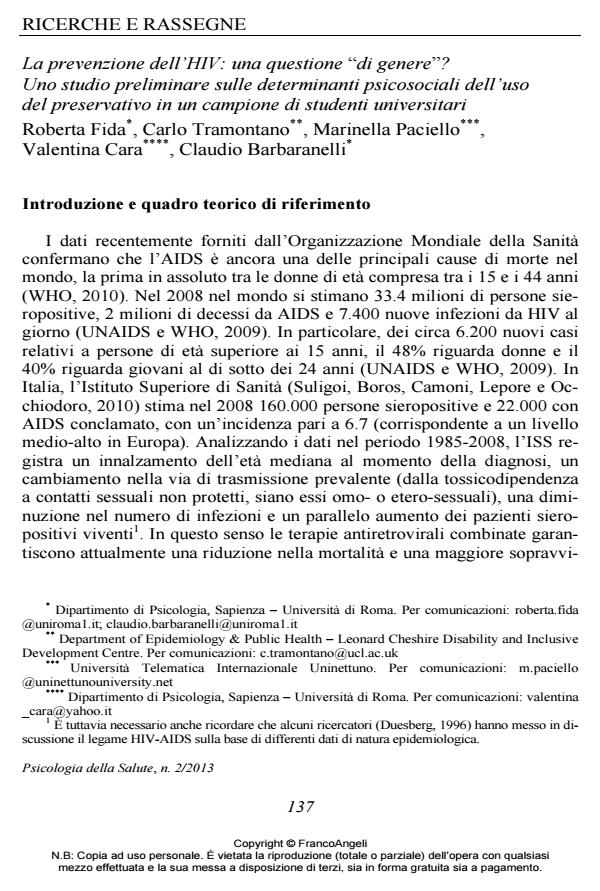HIV Prevention: is it a matter of "gender"? A preliminary study on psychosocial determinants of condom use in a sample of college students
Journal title PSICOLOGIA DELLA SALUTE
Author/s Roberta Fida, Carlo Tramontano, Marinella Paciello, Valentina Cara, Claudio Barbaranelli
Publishing Year 2013 Issue 2013/2
Language Italian Pages 22 P. 137-158 File size 768 KB
DOI 10.3280/PDS2013-002009
DOI is like a bar code for intellectual property: to have more infomation
click here
Below, you can see the article first page
If you want to buy this article in PDF format, you can do it, following the instructions to buy download credits

FrancoAngeli is member of Publishers International Linking Association, Inc (PILA), a not-for-profit association which run the CrossRef service enabling links to and from online scholarly content.
The present contribution investigates gender differences in psychosocial determinants of condom use in the framework of Theory of Planned Behavior of Fishbein e Ajzen as norms and control perceptions. Two hundred seventy one college students of "Sapienza" University of Rome (60% females) ranging in age between 18 and 41 years (M = 23.5, SD = 3.17) participated to the research. ANOVA and structural equation model results confirmed that the intention of condom use is influenced by many factors, differently among males and females. Results suggested that gender is an important moderator of the relations among the constructs theoretically defined. In this sense, almost in some measure, the form of the model changes in the two groups. As a consequence, it is mandatory to design and implement intervention programs that besides common matrix included also gender specific components.
Keywords: HIV, Condom use, Gender differences, Theory of Planned Behavior
- Conoscenze e comportamenti degli adolescenti in ambito affettivo-sessuale: una ricerca esplorativa Elena Canzi, Miriam Parise, Laura Ferrari, Maria Giulia Olivari, in RICERCHE DI PSICOLOGIA 2/2020 pp.575
DOI: 10.3280/RIP2020-002006
Roberta Fida, Carlo Tramontano, Marinella Paciello, Valentina Cara, Claudio Barbaranelli, La prevenzione dell’HIV: una questione "di genere"? Uno studio preliminare sulle determinanti psicosociali dell’uso del preservativo in un campione di studenti universitari in "PSICOLOGIA DELLA SALUTE" 2/2013, pp 137-158, DOI: 10.3280/PDS2013-002009